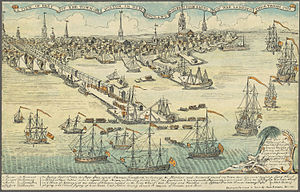Massachusetts Circular Letter
The acts placed an import duty on glass, paint, paper, lead, and tea as well as establishing an American Board of Customs.
Massachusetts received positive responses from New Jersey, Connecticut, and the Virginia House of Burgesses.
[3] In the Circular Letter, Samuel Adams argued that the Townshend Acts were unconstitutional because the colony of Massachusetts was not represented in Parliament.
[4] Instead, Adams argued in favor of the previous arrangement, where the colonies were taxed only by their own provincial assemblies in which they were already represented.
Arriving in October 1768, the soldiers only increased the tensions, as recorded in the anonymously penned "Journal of Occurrences", which chronicled the occupation.
